The British Sikh Heritage Museum
Presents Very Rare Manuscripts on Sikhism
SH1. Bani Behangam- A Unique work on Gurmat Spiritualism and metaphysical philosophy created during the period of Guru Angad Dev. It is based on Japji Sahib and Sidh Gosht. Experts on manuscripts reckon it to be the first ever work written in the Gurmukhi script and appeared in the form of a book.
SH2. The third Guru Amar Das established 22 centres of Sikhism known as 'Manjis'. The grandson of the Great Guru Baba Sahansar Dass was the master scribe who wrote many Gutkas of Gurbani which were duly sent to all the Manjis. We have discovered one such Gutka from a secret place in Afghanistan. The Gutka is of Assa di Vaar by Guru Nanak Dev. It was scribed before the fourth Guru Ram Das, whose Chhakay Chhand were incorporated in the Assa di Vaar later on. Written in early script on Sanihandmade paper the Gutka is complete and perhaps the only surviving one in the Sikh World.
SH3. The third Pothi of Goindwal. For the compilation of the Adi Granth, Guru Arjan Dev acquired Pothis of Gurbani from Goindwal. Two of these Pothis are preserved with two historic families in the Punjab. The third Pothi was missing all through the centuries. We are lucky to find a large manuscript of Gurbani, which contains all the Banis of the missing third Pothi of Goindwal.
SH4. UTTHANKA GRANTH SAHIB KI - A unique work on etymological sources of the Sikh Scriptures - This exposition is by Guru Gobind Singh scribed by Bhai Mani Singh in Sri Anand Pur Sahib. We have procured three versions of this annotated encyclopaedia of the Granth Sahib as under given:- i. Large volume scribed by Bhai Mani Singh. ii. Profusely illuminated version commissioned by a Sikh ruler of the 18th century. iii. A scholarly version by some Udasin Sadhu of that period. All three versions are intact and properly microfilmed for the posterity. There is a need for this work to be edited and published for the inquisitive sangat.
Ut-thanka Granth Sahib Ki
One of the unique, prized and extremely rare collection of the World Sikh Heritage Museum is Ut-thanka Granth Sahib Ki by Sri Guru Gobind Singh Ji. The term Ut-thanka means etymological connotation. Dr. Balbir Singh of Panch Vati, Dehradun (younger brother of Bhai Sahib Dr. Vir Singh Ji, was working on a similar project, which was sponsored by Panjabi University, Patiala. Part one of his NIRUKAT was duly published. Before he could continue on to the next phase he passed away and at his death, the project came to a standstill. He was very much interested ion the great Ut-thanka Granth of which Bhai Kahn Singh Nabha left no stone unturned to find this great treasure. He even visited Afghanistan in search of this Granth and the Damdami Bir Sahib, which Abdalli took away from the horrible big holocaust of Kup-Rahira. He was disappointed not to trace the lost treaseure.
With the divine grace our team is successful in acquiring the great treasure. We are pleased to share with the inquisitive sangat that we have now three recensions of Ut-thanka. And indeed out of 29 Granths not available anywhere in the world, we humbly submit to you that 22 are safe in our care. Collection was the first task, which is accomplished by the benign blessings of Waheguru. The next step is to make them available to you in one form or the other. Most of them are now microfilmed. Ut-thanka needs immediate publication for which your support is solicited.
Allow me to highlight one astonishing connotation from Jap Nisan:
mMny
(1) mgun (2) clY pMQ (3) = Original text.
Meanings: (1)
siqnwm ky mMnn krx vwly (2) mgn ho kr (3) ivcrqy hY vw klpq pMQoN mY pwau nhI
Drqy ]
This excellent creative work in dynamic interpretation resolves a number of dichotomic issues of the scriptures. An illustration is included in the menu of this input.
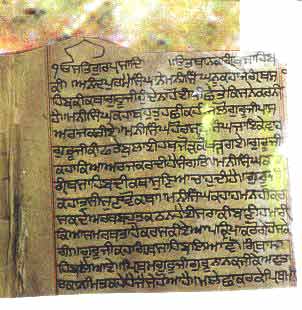
A
Page from the Ut-thanka
SH5. IQBAL NAMAH SARKAR (Persian) A unique and monumental manuscript on the life and times of Gurus, Sikh Misaldars and consolidation of Lahore Durbar by Maharaja Ranjit Singh. Raja Ram Tota, the chief scribe of Royal Lahore Durbar, writes it. His father was the master designer of Kanwar Nau Nihal Singh's marriage celebrations and also responsible to look after VIP's and guest English Generals. This manuscript runs into large size thousands of pages sprinkled with gold throughout. Horoscopes and Bansavli Namahs are in Sanskrit and Persian - all profusely illuminated. There are 21 chapters. Description of Forts and Gardens, capture of Kashmir and many secret reports are composed in Masnavi style poetry. Details of top Officers, Ministers, Rulers, Generals (foreigners as well), Artillery-accord, Jamburkhana, Feelkhana, Stables and their officers, details of state expenditure, civil administration and land revenue and judiciary system including eye-witness reports on treaties, Anglo-Sikh wars, Maharani Jindan and exile of Maharaja Duleep Singh and day to day life of common people - all superbly explained. It is an encyclopaedia of Punjab.
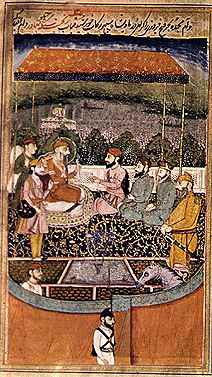
Maharaja Ranjit Singh with courtiers in his mature years. Miniature painting from the IQBALNAMA in imitation of the Pahari-Mughal Kalam.
SH6. A vast collection of Panjabi scrolls. There are 12 scrolls in the well preserved collection as under given:- 1 Five great items in this scroll, a. Mangal Nanak Naam, b. Suhag Nanak Naam Naal, c. Lagan Baba Ji Sambhodat, d. Lavan Dass Nanak Naam, e. Ghori Nanak Naam Naal. 2. Nau Ras Kavita by Gurbax Singh. 3. Kaih Mukarnian and Rekhta by Amir Khusrau. 4. Bahal Singh's Mahakaav. 5. Sri Sudha Sampardai about Nirmal Panth and Kavi Harbhajan Singh on Guru Gobind Singh. 6. Poetry on Guru Nanak Dev to Guru Arjan Dev. 7. Lehndi Punjabi Kissa Kari 1661 Bikrami. 8. Ustat Baba Sahib Singh Bedi. 9. Photak Dohras. 10.Bara Maha Sri Krishan Ji. 11.Tantaric Scroll Lahore Durbar. 12.Gurbani Scroll which Guru Gobind Singh always kept in the Gatra.
SH7. Illustrated Janam Sakhi of Guru Nanak Dev by Bhai Faqiria - a Diwana Sadhu. He was a teacher of Alam Raj who illustrated the India Office Library Janam Sakhi B40. There are 64 paintings of one illustration to each episode by an unknown chief of the 18th century. This unique manuscript is in a very good state of repairs and currently a Ph.D. Scholar is working on a research project with this manuscript
SH8. A Das Granthi manuscript. The Granth contains great Gurbani with a selection from Guru Gobind Singh. The scribe is famous Baba Hardas Singh who worked under Bhai Mani Singh at Sri AnandPur Sahib. The manuscript can resolve a number of textual issues of Gurbani.
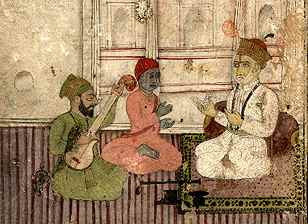 A
very rare painting of Guru Nanak with Mardana and an ascetic.
A
very rare painting of Guru Nanak with Mardana and an ascetic.
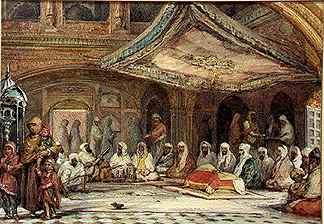
WORLD SIKH HERITAGE MUSEUM
Main Features of Collection
Guru Period 1469-1708 (239 years of Sikhism and its foundation)
Guru Nanak Dev's original Janam Sakhi, Bani Behangam, Behr-i-Tavil, very rare manuscripts on Udasis, Shrines and Relics, a special collection on Jap Nisan (the first title of Japji Sahib) with Tikas, Paintings of Guru Patshah by 100 artists, manuscripts of annotated Gurbani and translations in many languages. VERY RARE ITEMS
1. Tiny gold impression of Guru's holy feet enshrined in Kathmandu.
2. Painting of Guru Ji visiting Sheikh Brahm Farid (Sh. Ibrahim Farid 12th successor of Sheikh Baba Masud Farid) in Pakpattan. It was painted by the Royal Artist Mohsin of Bahawalpur State who died in 1538 AD and its provenance is Uch Shareef.
3. Oil painting by late S.Sobha Singh portraying Guru Nanak Dev Ji bestowing Guru Gaddi on to the dedicated successor Bhai Lahna Ji, who becomes Guru Angad Dev after this historic ceremony. The five current coins (1539) shown in the tray are now preserved in our museum.
4. Guru Nanak Dev's Divine and melodious 'Bani' -"Assa-di-Var" was scribed during Guru Angad Dev's Guruship - in the form of a Gutka which was enshrined in one of the 'Manjis' established by Sri Guru Amar Das Ji. The orthographic research on this unique and only one available manuscript of Sikh scriptures highlights an important feature of its linguistic structure, which proves its originality and antiquity. It is combining the HORA symbol in the first letter "Oorah" as appears on the reverse of page 11. Another evidence reaffirming this finding is the absence of the 'Chhakas' of the 4th Guru Ram Dass Ji, which were incorporated to the 24 Pauris later on. However a couple of relevant shaloks by Guru Angad Dev Ji are scribed at the appropriate place. An Asa di Var without Shalok M2 would be the one prepared by the founder father himself or by one of his scribes.
5. On the most auspicious Gurpurab of the Parkash Quincentorial celebrations of Guru Nanak Dev's holy birth. Our humble team displayed 500 original and exquisite exhibits at the Royal Albert Hall, London. Many more items have been added to this section of our collection, which itself needs a large museum to house. We are very fortunate to acquire a number of items from Princess Bamba Duleep Singh's wonderful collection. There are albums of photographs and paintings, masterpieces of textile and fabric arts, manuscripts and out of print books, private letters and other documents. One item which is really astonishing is an 18th century silver craft depicting Guru Nanak Dev, Bhai Bala with peacock feather chaur and Bhai Mardana playing the 'rabab', all sitting in the shade of a tree. A birdcage with a bird is hanging under the tree. The princess got it repaired, mounted on a board of velvet and framed in Lahore (1908). This art is known as REPOUSSE in the contemporary art world.
6. The Sikh Numismatics. Sikhisim possesses an interesting variety of cultural and heritage developmental aspects. The concept of Miri and Piri was introduced by Guru Hargobind Sahib which culminated at the time of the great 10th Master in the form of creating a true Saint and Soldier. The founder of Sikhism himself established the foundation of Nanak-Shahi Taxal. The first Bani (Jap Nisan) that we recite at the Amrit Vela i.e. two and half hours before the sunrise (which is one-tenth of 24 hours of day and night) highlights an illuminating divine message: "GVIAY sbd scI tkswl ]" "Mint the holy Hymn at the True Mint !" Guru Arjan Dev compiled this MINT and his illustrous son expressed it through MIRI and PIRI. Miri is the Sword and Nanak-Shahi mint while Piri is recitation of the holy hymns through chivalrous music of Dhad and Sarangi. A very rare token depicting Guru Nanak Dev's horoscope could be seen in our museum, which displays the largest collection of Sikh coinage (Banda Bahadur's Gobind Shahi Taxal, the Misl taxals on horse back and Khalsa Durbar various Mints. A comprehensive study of Sikh Numismatics is overdue for which our heritage-centre could prove very helpful.
7. Granths written by Bhai Hardas Singh who was a great scribe in service of Guru Gobind Singh. He was the famed grand father of Maharaja Jassa Singh Ramgarhia. His masterpiece (Adi Granth) was enshrined in the Sikh Reference Library. The World Sikh Heritage Museum has now collected three granths by this great manuscript writer. Here are two pages of a Gutka written and illuminated by him.
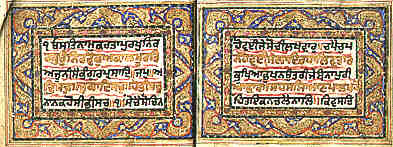
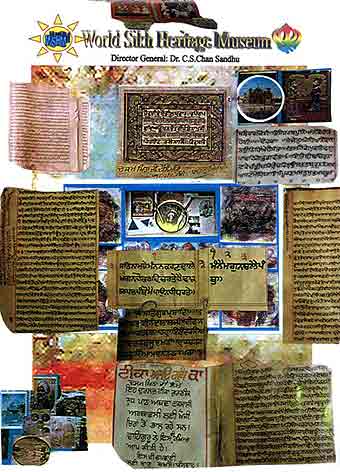
Some manuscripts in care of WSH Museum
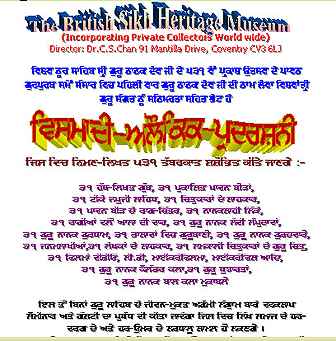
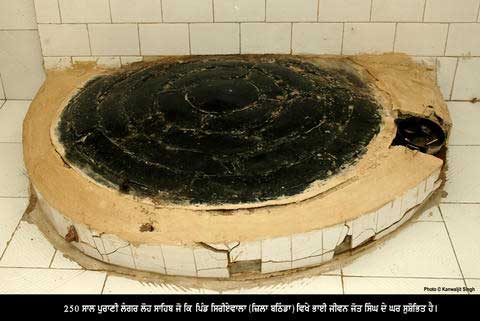
A 250 year old 'Langar loh' (metal plate for making rotis) at village 'Sirianwala'-dist Bathinda at the house of Bhai Jeevan Jot Singh -Courtesy Prof Balwinder Singh
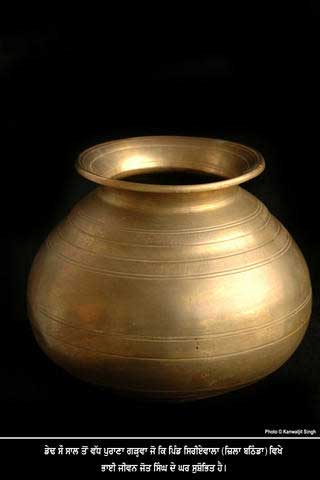
150 year old metal pot (Gadwa) also at the above village - Courtesy Prof Balwinder Singh
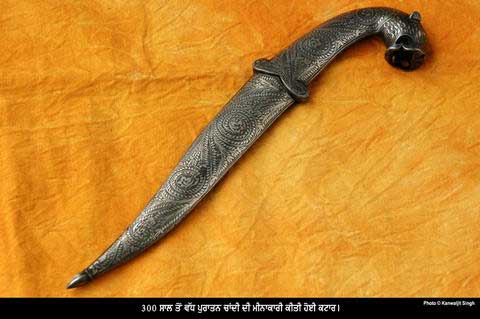
A 300 yr old dagger in silver with beautiful engravings-Courtesy Prof Balwinder Singh
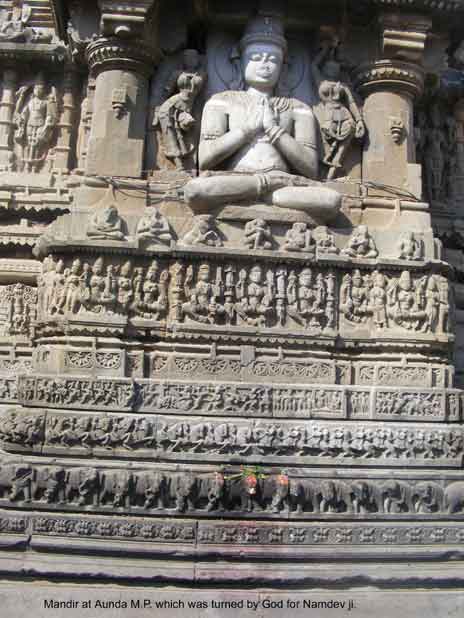
(courtesy Prof. Balwinder Singh)
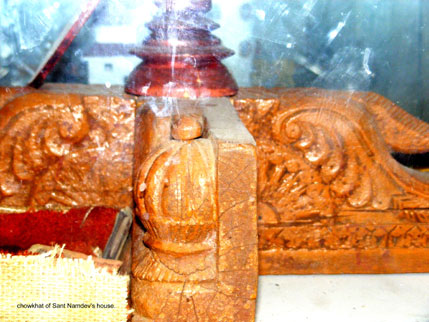
'chowkhat' of Sant Namdev's house (courtesy Prof. Balwinder Singh)
'Back